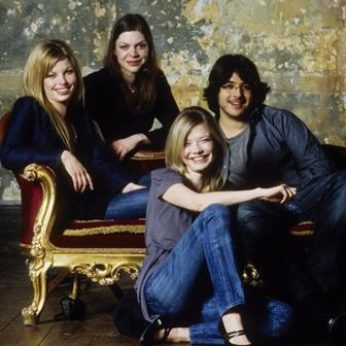Composer: Wolfgang Amadeus Mozart (b. 1756 - d. 1791)
Performance date: 01/07/2010
Venue: St. Brendan’s Church
Composition Year: 1789
Duration: 00:33:09
Recording Engineer: Anton Timoney, RTÉ lyric fm
Instrumentation: 2vn, va, vc
Instrumentation Category:Clarinet Quintet
Instrumentation Other: 2vn, va, vc, bcl
Artists:
Chiaroscuro Quartet (Alina Ibragimova, Pablo Hernán Benedí [violins], Emilie Hörnlund [viola], Claire Thirion [cello]) -
[quartet]
Chen Halevi -
[basset clarinet]

It is inevitable that composers are
inspired to write works for specific individuals or ensembles. In the
most obvious cases, virtuoso composers write works for themselves,
especially early in their careers. Beethoven and Mozart were both
superb keyboard players and wrote works that they would then premiere
themselves, most especially in the case of Mozart’s piano concertos.
Much would depend on the composer’s primary source of income and
their facility of composition. Brahms, famously, never composed to
commission, but was able to make his living from a combination of
performance honorariums and publication fees. This meant he was at
liberty to compose whatever he wanted and most of his chamber works
would have been written with specific performers in mind. Today
composers rely heavily on commissions, which means that they often
have the performers chosen for them.
Mozart made his living in the most
hazardous way with an erratic combination of performance and
publication fees, with his cash-flow problems subsidised in the
modern manner by heavy borrowing, especially from fellow Freemasons.
Unlike Beethoven he never managed to secure rich and reliable patrons
and unlike Haydn he never had a secure salaried post. However, like
Schubert, who was similarly impecunious, he composed at great speed.
So when Mozart was in the middle of composing and producing Cosi
fan Tutti in the autumn of 1789, he could still find time to turn
aside from this and write a quintet for his friend Anton Stadler, the
famous clarinettist.
They had met by 1784 as Stadler is
known to have taken part in the premiere of the Gran Partita in March
of that year. After that they often worked together and Stadler would
have played in the various orchestras that premiered Mozart’s
symphonies, concertos and operas. Stadler was also a Freemason, so,
when he requested a new work for a Christmas concert, Mozart set
aside the opera and got to work. There was another musical reason for
Mozart’s interest in writing a quintet, Stadler had recently invented
a new instrument known as a basset clarinet. No example of it
survives, but it was known to extend the range of the normal clarinet
by a major third. Unfortunately Mozart’s autograph score has not
survived, but the original version and the unusual instrument have
been reliably reconstructed and this is what we hear today.
The Clarinet Quintet has several
features that are also found in the Prussian Quartets. Just as the
cello, in the first Prussian Quartet, is slow to reveal the prominent
role it is going to play, so does the clarinet for a surprisingly
long time play only unimportant material. In the first subject it
bridges gaps between string phrases and only gets to play out in the
second, less important part, of the first-subject group. The second
subject is given to the first violin alone, until the clarinet
eventually takes it over as the music changes to the minor mode. This
temporary darkening of the A major mode allows the clarinet to show
off its wonderful range of colours.
The graceful Larghetto gives the
clarinet the opportunity to display its lyrical qualities to the
full, especially in the magical, flowing melody that opens the
movement. This is music to fall in love to, time cannot quench its
beauty and, at every hearing, Mozart weaves his unique spell. The
double minuet awakens us from our trance and the clarinet is allowed
to retire during the first trio, given to the strings alone. The
witty finale is a theme and five variations with a coda. As in the
first movement the solo instrument must, in the true spirit of
chamber music, wait to take its turn. The chirpy theme is stated by
the two violins and the clarinet is confined to brief cadential
flourishes. So in the first variation the clarinet is given the
theme, and in the second variation it is the turn of the viola and
cello. The third variation is traditionally in the minor key and here
the dark colour of the viola is given first place. After this the two
violins take charge while the clarinet dances delightedly around
them. Finally we come to the Adagio variation and again the strings
begin without the clarinet, who later melts into the texture. The
Allegro coda is a joyful summary of the spirit of the theme.
Copyright © 2025 West Cork Music. All rights reserved.
Designed and developed by Matrix Internet